Mi-38. A story of forty years
Previously, this was not
To be precise, in 2020, the idea and concept of the Mi-38 marks 39 years. On June 30, 1981, the CPSU Central Committee and the Council of Ministers decided to begin work on a new rotary-wing aircraft, which received the original name Mi-8M. Until now, opinions about which replacement helicopter a new helicopter was planned vary. Some sources write that the Mi-38 was to become a new, more advanced Mi-8. Others say that the machine covered the market gap between the average "magnificent eight" and the heavy Mi-26. Indeed, the world's largest 26th Mile takes 20 tons on board at once, while the Mi-8 takes no more than 3 tons. It turns out that cargoes weighing from 4 to 10-12 tons have to either be transported by a giant Mi-26, or by several Mi-8 flights. Both that, and another, naturally, economically unprofitable. In addition, they planned to install the TV7-117 engine on the new helicopter, which was both more powerful and more economical than the predecessor TV2-117. The new engine was to be developed by the Leningrad Engine-Building Design Bureau, which is now called the Klimov Design Bureau. The special hopes for the Mi-8M, which later became the Mi-38, were with the civilian carrier Aeroflot: it required a highly profitable cargo and passenger helicopter. In particular, it was planned that with a greater carrying capacity, the cost of a flight hour on the Mi-38 will be comparable to the younger Mi-8.
In addition to the new engine, the Mi-38 was supposed to get an aerodynamically more advanced fuselage than the Mi-8. Firstly, the tanks were removed under the floor of the cargo compartment. This saved the car from protruding hips in the manner of the G15. Such a solution both reduced the drag of the helicopter and also reduced the resistance of the rotor. Elastic fuel tanks guaranteed the safety of emergency landing (actually falling) from a height of 38 meters - kerosene did not spread and did not ignite. The car was initially considered as a passenger or transport, therefore, wings were not provided for possible weapons. This decision also had a positive effect on the traction capabilities of the rotor. Secondly, the engines on the Mi-8 were located behind the main gearbox, so the car received such a profile uncharacteristic for Mil helicopters. Now the helicopter began to resemble some kind of Agusta Westland. This layout solution has reduced vibration in the cockpit, as well as reduced drag. In total, the harmful resistance of the helicopter compared to the Mi-20 decreased by XNUMX%, which, coupled with more powerful engines, immediately brought the helicopter to a completely different league.

The Mi-38 in terms of load capacity is located between the medium Mi-8 and the heavy (or superheavy, as it is called in NATO) Mi-26
The next innovation for the early 80s was the use of a four-blade X-shaped tail rotor. The design was worked out simultaneously for the combat Mi-28 and civil Mi-38. In 1981, at the screw stand of the MVZ them. M. L. Mila, under the direction of A. S. Braverman, conducted comparative tests of the classic three-blade tail rotor from the Mi-8 and Mi-24 with the new X-shaped, confirming the high efficiency of the X circuit. The Mi-8M design headquarters in the early 80's In addition to the above, he also provided for the helicopter with an elastomeric rotor hub (does not require lubrication), a retractable landing gear, as well as the most advanced aerobatic complex for its time, which allowed two people to remain in the crew. When in 1983 we looked at how much work remains to be done, we decided to rename the project to Mi-38. And the Mi-8 line continued its career in the form of various modifications and minor improvements, because, as they say in Mil Design Bureau, the potential laid down in the “magnificent eight” has not yet been exhausted.
The thorny path of the 90s
When the approximate appearance of the Mi-38 in the form of a preliminary design developed by the beginning of the 90s, it turned out that the payload was 5 tons, the normal weight was 13 tons, and the maximum weight was about 14,5 tons. Compared to the Mi-8, the novelty exceeded the well-deserved helicopter in terms of carrying capacity by 1,8 times, by productivity by 2 times and by efficiency by 1,7 times. In the wake of the collapse of the Soviet Union, they decided to mass-produce the Mi-38 and even started re-equipping the Kazan Helicopter Plant. A year earlier, a helicopter model was shown at the Paris Aerospace Salon. In the USSR, they hoped for the car to enter the markets of developed countries, for this certification was provided for according to foreign airworthiness standards. The mock-up commission for the Mi-38 machine was held in August 1991, where the decision was made to launch production, and the full-scale mock-up of the helicopter was first demonstrated at the Moscow Air Show. Like many other domestic projects of the turn of the 1992-80s, the new helicopter was the victim of a lack of funding, as well as the loss of some of the allies - many were abroad.
Since initially the Milevians did not particularly count on the contracts of the Ministry of Defense, their views turned to their Western partners. The first to respond and independently choose the Mi-38 managers from Eurocopter as a partnership project, who concluded in December 1992 with the cost center named after M. L. Milya a preliminary agreement on cooperation, and two years later even created a joint CJSC Euromil. A company was formed, which directly included the Mil office, Eurocopter, Kazan Helicopter Plant (serial production manufacturer) and FSUE Zavod im. V. I Klimova ”(motor production). Klimovtsy were responsible for the development and refinement of the very TV7-117V, which was discussed in the early 80s. This turboshaft power unit was to develop 2500 liters. sec., while in emergency mode, in case of failure of the second motor, it could give out 30 liters within 3750 seconds. from. In addition, an important parameter of the operation of the TV7-117B was the ability to function with an idle oil system for half an hour. All this allowed us to talk about the high reliability and safety of the power plant of two engines of the Klimov plant, as well as about high chances to take a place in the army aviation Russian army. What did Eurocopter do at this company? On his shoulders were onboard flight and navigation equipment, cockpit interior and control systems. Also, the Europeans promised some kind of assistance in the promotion and certification of the car in the markets of foreign countries. A strange decision, since the Eurocopter portfolio already included a similar EC-225 SuperPuma. Looking ahead, let us say that, in fact, for Eurocopter, Euromil CJSC existed until 2017. By the way, when the Klimovites refused further cooperation and actually left the helicopter without an engine, they had to turn to the Canadian Pratt & Whitney for help. In 1997, the Milians were then given the actual two PW-127T / S engines - in Canada it was hoped that if the Mi-38 went into production, the power plant would be exclusively Pratt & Whitney. Indeed, the first flight of the Mi-38 was made with Canadian engines, but only much later than planned - December 22, 2003. A few years later, Canadians will be banned from cooperating with the Mil plant, so as not to supply equipment for Russian dual-use products.
If we compare the Mi-38 with potential competitors, which were born much earlier and have already managed to conquer sales markets, it turns out that the Russian machine looks at least aerodynamically perfect. Among the classmates, the EC-225 SuperPuma from Eurocopter, the S-92 from SikorskyAircraft and the AW-101UT from AgustaWestland, which lose the Mi-38 both in maximum load capacity and speed with a flight range, stand out. Declared by the developers, the parameters of the helicopter in terms of price, economic and technical indicators at one time put it generally out of competition. True, this largely related to the Mi-38 with PW-127T / S engines, which now, for obvious reasons, will never appear on the machine.
If we compare the Mi-38 with the younger brother (if we are talking about the class of the car, and not about the age) of the Mi-8, then the cost of a ton-kilometer when flying to a range of 800 kilometers on the 38th car is seven times lower than that of the well-deserved eight even in the latest version. In addition, on helicopters of the Mi-8 family, the replacement of rotor blades is required once every seven to eight years: the developers of the Mi-38 claim that the composite plane of the rotors will serve throughout the life of the machine. The rotor blades are made according to the technology by the method of winding a “prepreg” of carbon fiber onto a rotating snap. Now in the domestic aviation industry, the use of composites is becoming a kind of rule of good form.
To be continued ...
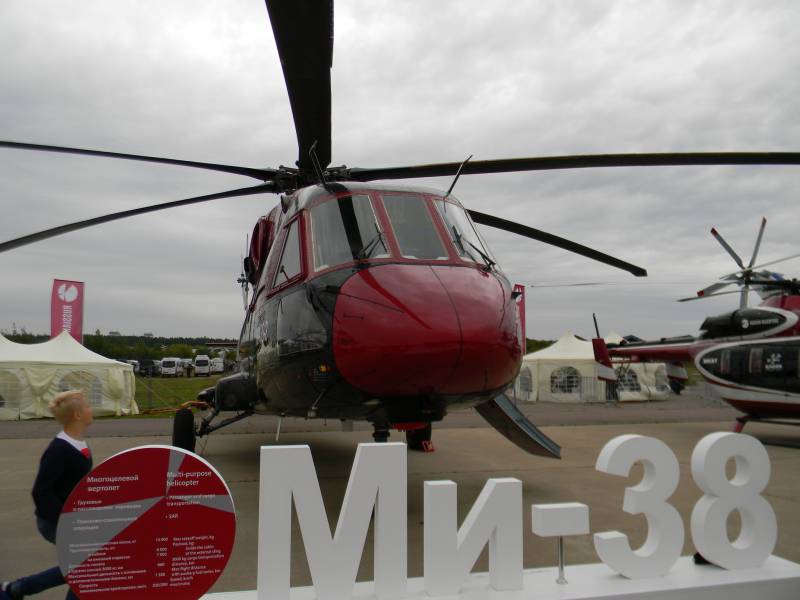
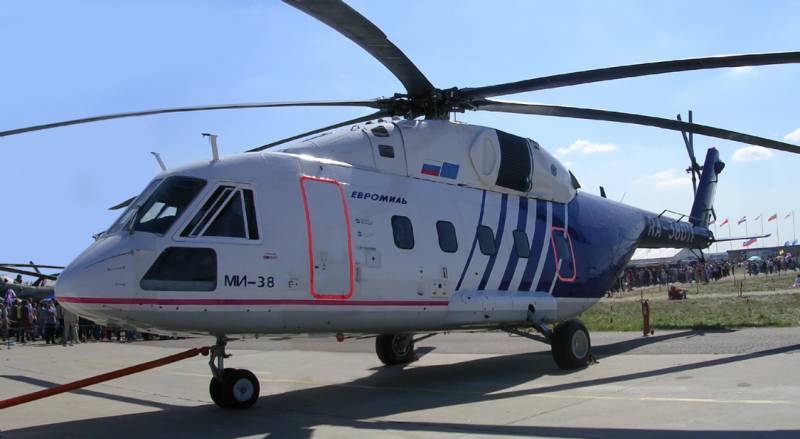
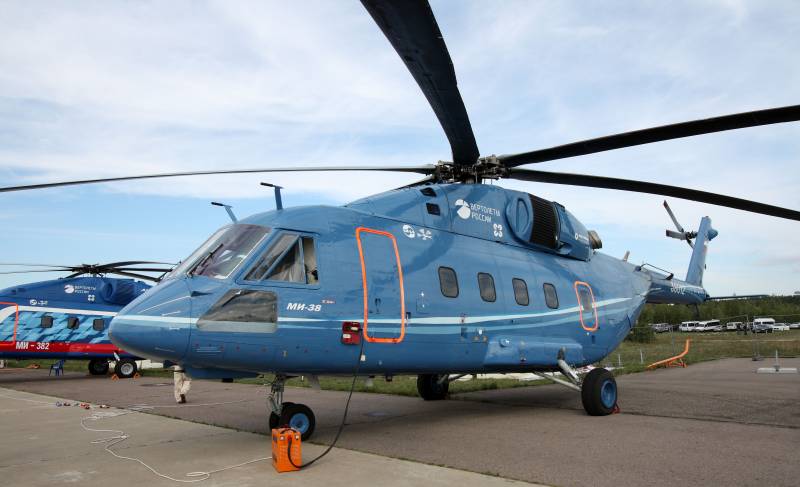
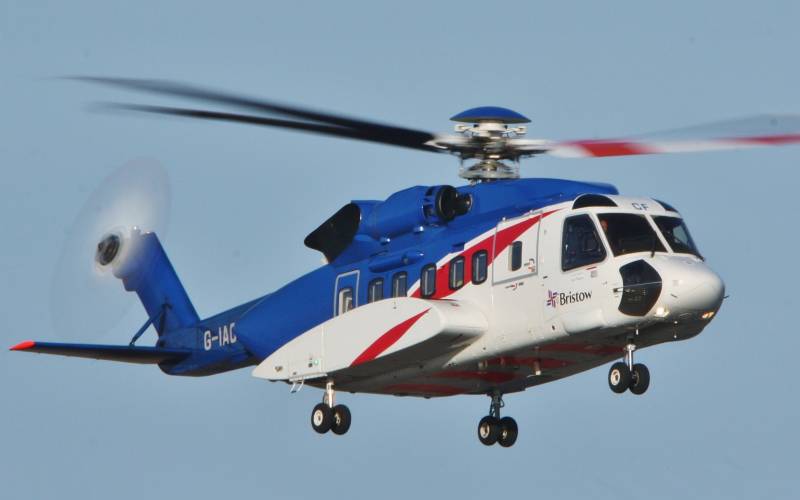
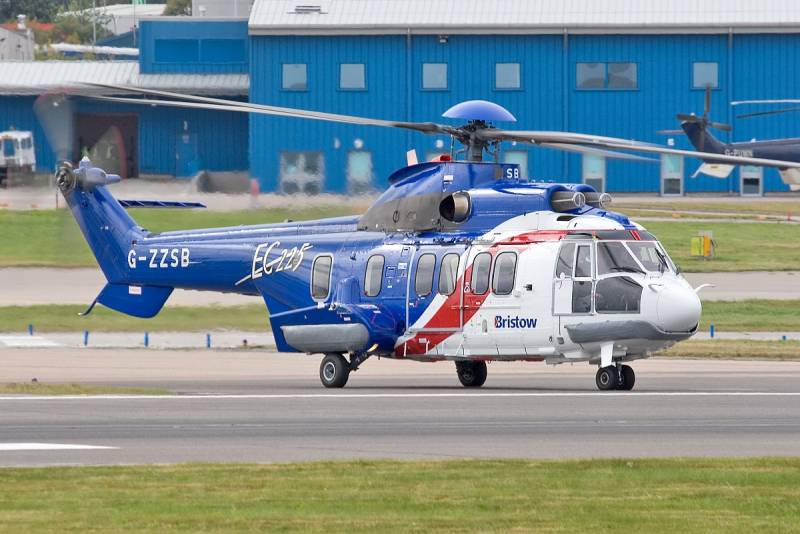
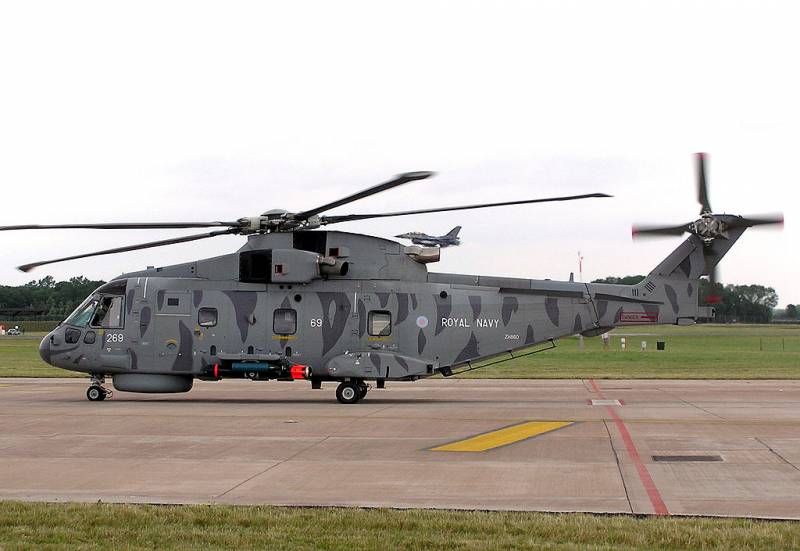
Information